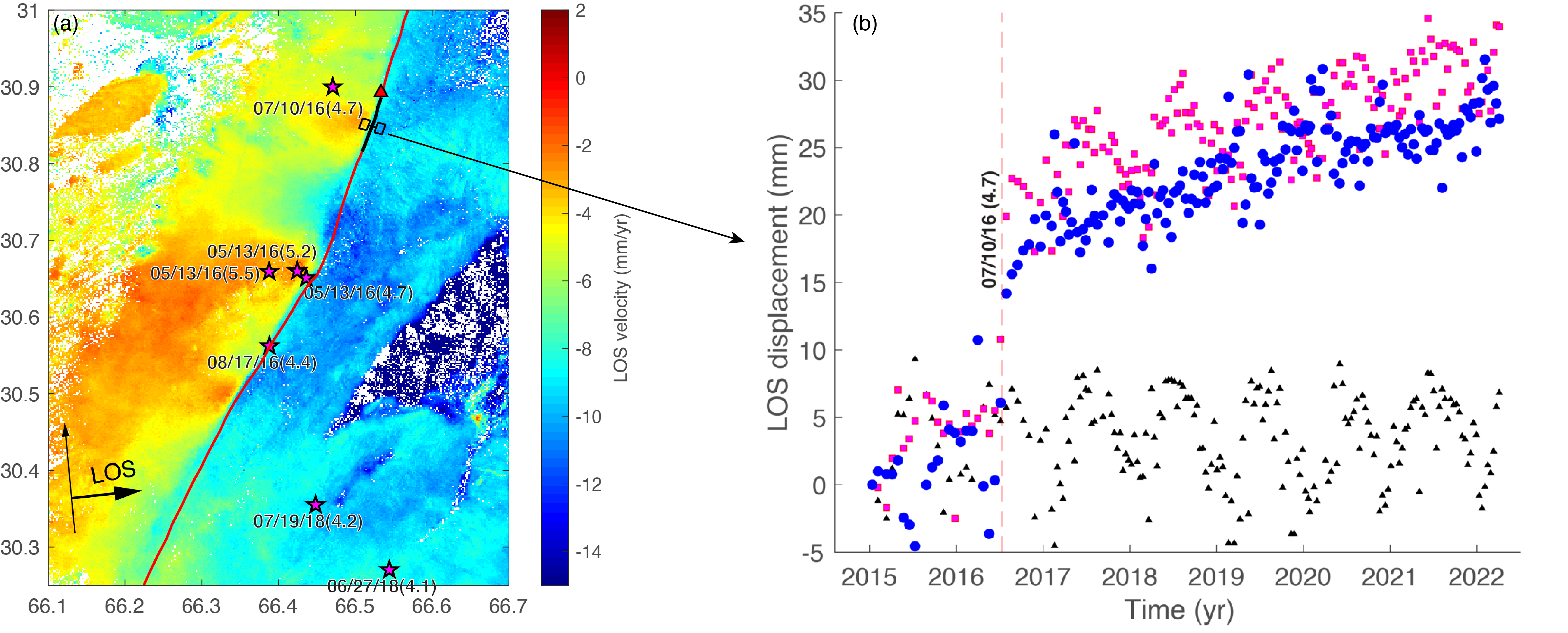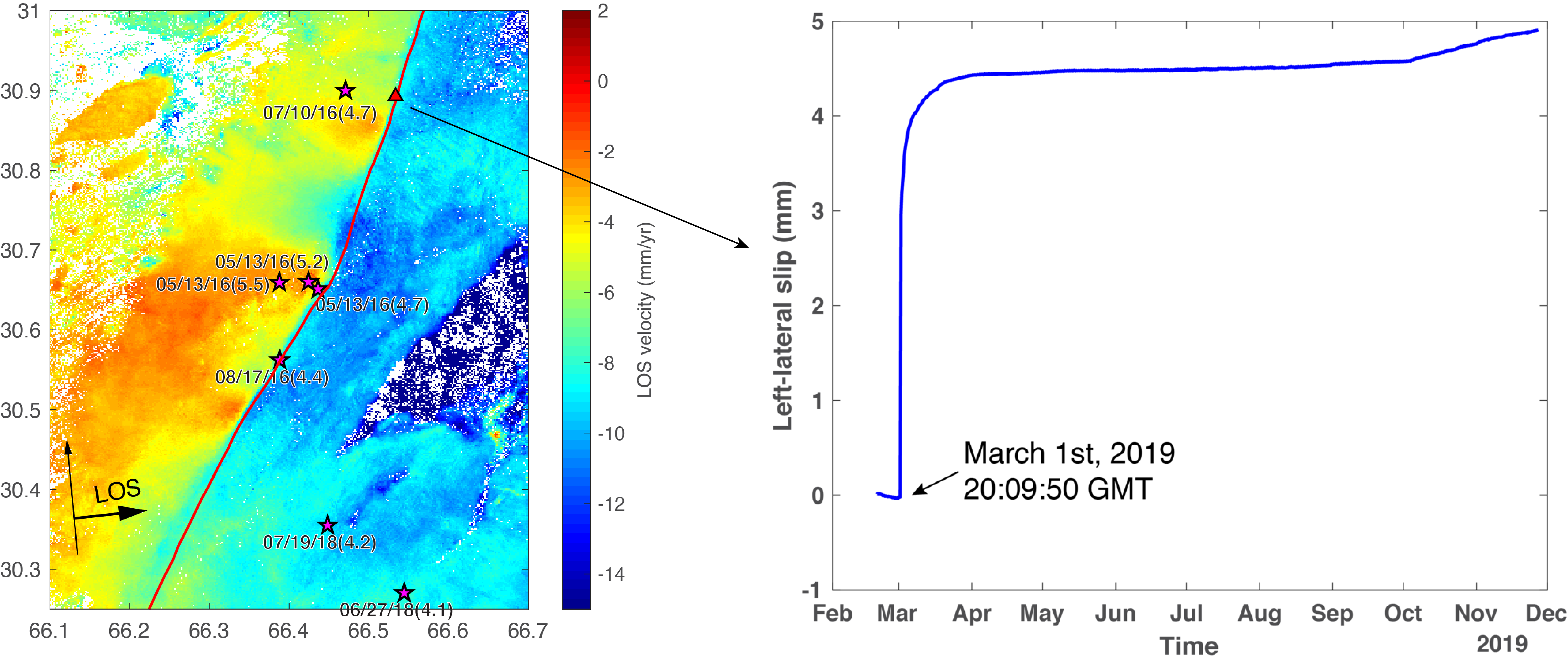
 |
|

Tectonic setting of the Chaman plate boundary and Sentinel-1 InSAR observations covering the central portion of the Chaman fault. (a) Geologic setting of the Chaman transform fault system. Black lines represent Quaternary faults from Mohadjer et al. (2016). Focal mechanisms represent earthquakes >M5 from 1976-2019; red stars indicate historical earthquakes >M7 (Ambraseys and Bilham, 2003). Blue vectors represent GPS velocities relative to stable India (Szeliga et al. 2012). White, magenta, and green rectangles indicate the ground coverage of SAR images from the ALOS-2 (ascending) and Sentinel-1 (ascending and descending) instruments, respectively. White squares show the locations of cities with populations >100,000. (b) Average InSAR line-of-sight (LOS) velocity covering the central portion of the Chaman fault (purple dash box in panel a) derived from Sentinel-1 data of the ascendign track T42 from 2015 to 2022. Red color represents motion toward the satellite, and blue represents motion away from the satellite. Note the sharp gradient in LOS velocity across the trace of Chaman fault, indicative of fault creep at the surface. The InSAR data also reveal clear and widespread ground subsidence across many of the residential and agricultural areas near the Chaman fault system in southern Pakistan. Particularly, up to >15 cm/yr of ground subsidence is observed across the Quetta valley, where the capital and largest city of the Baluchistan province is located. From 2015 to 2022, the central portion of the Quetta valley has produced ~1 meter of ground deformation along the radar line-of-sight (panels b-e). We also notice that although the LOS deformation related to the groundwater extraction is mostly linear with time, removing a best-fit linear trend from the original time series reveals clear seasonal variations in the residual deformation time series across much of the Quetta valley (red dots in panel c), indicating that part of the aquifer compaction in the Quetta valley is still elastic and recoverable, so timely recharge and proper management of groundwater usage may prevent further damage and permanent loss to the storage capacity of the aquifer.

Between 29.5N and 31.5N, the creep rates revealed by the Sentinel- 1 data vary between 0-8mm/yr, generally in good agreement with previous estimates with Envisat ASAR data from 2004 to 2010 (Barnhart, 2017). However, compared to earlier studies, the dense and regular acquisitions of the Sentinel-1 missions allow us to characterize the fault creep and regional ground subsidence due to groundwater extraction at a much higher accuracy and temporal resolution. The Sentinel-1 InSAR shows that the average surface creep rates along the radar LOS are as high as 25-30 mm/yr, significantly higher than the overall slip rate of < 16mm/yr on the Chaman fault (Szeliga et al., 2012). The segments of the high creep rates are coincident with locations of a sequence of M4-5 earthquakes around the Chaman fault in 2016. Close examination of displacement time series reveal that the three earthquakes on July 10, 2016 not only produced clear surface offset across the fault, but also enhanced creep months after the events (panel b). Magenta squares in panel b represent the surface creep time series derived from Sentinel-1 InSAR observations without correcting for the atmospheric noise. Blue dots represent the results after correcting for the atmospheric noise using ERA-5 weather model. Note that the apparent seasonal variation in the time series without the atmospheric noise correction is well predicted by the ERA-5 weather model (black triangles). This is because there is an elevation contrast across the fault, which causes a difference in the seasonal amplitude of the tropospheric delay and the resulting creep estimates. We also notice that surface creep behavior along the Chaman fault seems to be quite dynamic and heterogeneous, in that on some portion of the fault, these earthquakes seem to only produce modest amount of coseismal offset, while on other portions, even a small earthquake off the fault can trigger a noticeable amount of enhanced creep on the Chaman fault.

In addition to high spatial-resolution InSAR, this project also aims to deploy several GNSS stations nd creepmeters to monitor the dynamics of fault creep and ground subsidence at high temporal resolution. One creepmeter deployed in early 2019 near the Chaman city has also recorded a spontaneous creep event that cannot be associated with nearby earthquakes.
| Project Summary |
The Chaman transform fault system of Pakistan and Afghanistan is one of the most prominent continental strike-slip plate boundary zones in the world. It stretches >1200 km from the Arabian Ocean in southern Pakistan to the Hindu Kush mountains in Afghanistan, forming the western boundary of the India plate with the Eurasian plate. The greater Chaman fault system has hosted a series of large and destructive earthquakes, including the 1892 M6.6 Chaman, the 1909 M7.1 Kachhi, the 1931 M7.3 Mach, the 1935 M7.7 Quetta, the 2013 M7.7 Balochistan, and the 2022 Khost (near the Afghanistan-Pakistan) earthquakes. Despite the history of large and destructive earthquakes, modern geodetic measurements across the Chaman transform boundary are limited, due to the harsh landscape and generally difficult access. To date, we do not know the individual slip rates and locking depths of faults within the Chaman fault system, nor do we know where interseismic strain is accommodated beyond the Chaman and Ghazaband faults. In addition to the tectonic loading, hydrological processes also generate and impact deformation patterns throughout the Chaman fault system. In particular, the rapid exploitation of groundwater has caused widespread land subsidence across much of the Indus basin and northern Balochistan. The groundwater extraction and resulting subsidence not only cause damage to buildings and infrastructure and permanent compaction of fine sediment layers, resulting in a significant decline in the groundwater level and the storage potential of the aquifer. Measuring and modeling the rates and impacts of surface deformation in agricultural regions and densely populated cities in Pakistan are essential to reducing the damage of local buildings and infrastructure due to land subsidence associated with groundwater extraction and to help the local authorities better manage the groundwater usage. The goals of this project are to quantify the spatial and temporal distribution of surface deformation along Chaman transform fault system in Pakistan and Afghanistan using satellite geodesy, including InSAR, GNSS, and creepmeter measurements; and explore the mechanical interactions between fault creep, interseismic loading, seismicity, and ground deformation associated with groundwater extraction along the Chaman plate boundary. The project is undertaken collaboratively with colleagues at the University of Baluchistan in Quetta and NED University in Karachi. In 2022 Najeeb Ullah’s research team in Quetta measured two dozen new GPS points throughout eastern Baluchistan, and established several new continuous monitoring points to provide ground control of our collaborative space-based InSAR studies. |
||
| Tools | GPS, InSAR and Creepmeter | ||
| Geographic Location | Chaman Plate Boundary, Pakistan | ||
| Group Members Involved | Kang Wang <Email> <Personal Web Site> | ||
| Roland Bürgmann <Email> <Personal Web Site> | |||
| Roger Bilham <Email> <Personal Web Site> | |||
| Project Duration | 2021-2024 | ||
| Publications | AGU2022 Presentation < AGU2022_Wang > | ||
| SRL2019 < SRL2019_Bilham > | |||